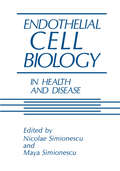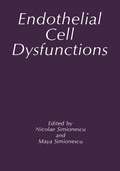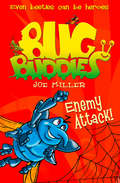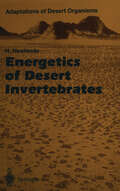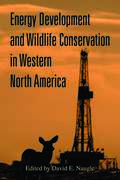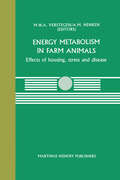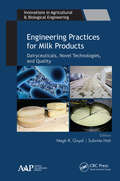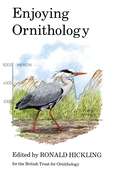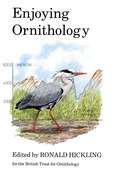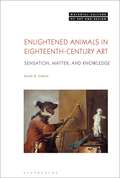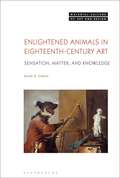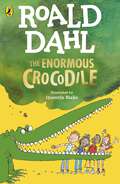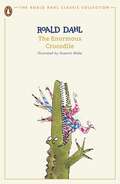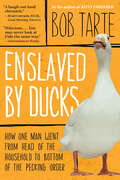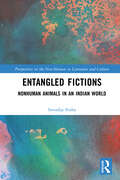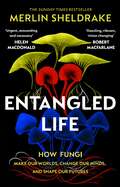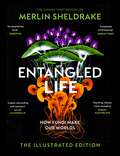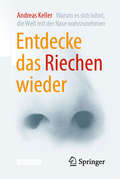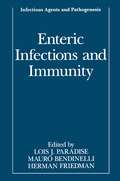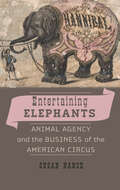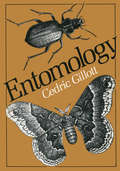- Table View
- List View
Endothelial Cell Biology in Health and Disease
by M. Simionescu N. SimionescuAlthough blood capillaries were first observed through a flea-lens microscope by Malpighi in 1661,200 more years elapsed before the cellular nature of the vessel wall was conclusively demonstrated. Beginning with the middle of the 19th cen tury, our knowledge of the histological organization of blood vessels has steadily increased. However, the endothelium, which for a long time was considered to be just an inert barrier lining, had been barely explored until three decades ago. Since then, there has been an upsurge of interest in the fine structure and function of endothelial cells. Intense in vivo and in vitro investigations have revealed that the endothelial cell is a key element in a wide variety of normal activities and diseases. A large number of investigators and laboratories have been attracted to endothelial cell research, thus supporting the expansion of the continuously grow ing and diversifying field of endotheliology. The number of articles published annually on this subject has increased from a few score at the beginning of the 1970s to more than a thousand in recent years, and an increasing number of journals, books, societies, and symposia focused primarily on the vascular en dothelium have marked the last decade.
Endothelial Cell Dysfunctions
by M. Simionescu N. SimionescuNoted experts survey and evaluate the latest research in the growing field of endothelial cell involvement in the initiation and development of various diseases. Research-oriented chapters span a diversity of topics, including endothelial cell response to various injuries and its crucial role in inflammation, immunity, viral infection, hypertension, hyperlipidemia, atherosclerosis, diabetes mellitus, neoplasia, and metastasis.
Enemy Attack! (Bug Buddies #2)
by Joe MillerEven bugs can be heroes! Join the Bug Buddies on bug-tastic adventures, as they pit their wits against the dreaded spider Spinner, creepiest of all creepy crawlies…
Energetics of Desert Invertebrates (Adaptations of Desert Organisms)
by Harold HeatwoleDesert invertebrates live in an environment where resources alternate unpredictably between brief periods of plenty and prolonged scarcity. This book describes the adaptive strategies of desert invertebrates in acquiring energy and sustaining life with such fluctuations. Some cooperate in foraging; others compete for resources. Some are nomadic and migrate to more favorable sites as conditions change. Others conserve energy by going into a deep dormancy until better conditions return. Still others store food during plentiful periods so as to retreat underground during less favorable times. The adaptive modes of economizing on scarce energy resources are diverse and lead to an appreciation of the intricate interactions of animals living close to their environmental limits.
Energy Development and Wildlife Conservation in Western North America
by David E. NaugleEnergy Development and Wildlife Conservation in Western North America offers a road map for securing our energy future while safeguarding our wildlife heritage. Contributors show how science can help craft solutions to conflicts between wildlife and energy development by delineating core areas, identifying landscapes that support viable populations, and forecasting future development scenarios to aid in conservation design.The book calls for a shift away from site-level management that has failed to mitigate cumulative impacts on wildlife populations toward broad-scale planning and implementation of conservation in priority landscapes. It concludes by identifying ways that decision makers can remove roadblocks to conservation, and provides a blueprint for implementing conservation plans.
Energy Metabolism in Farm Animals: Effects of housing, stress and disease (Current Topics in Veterinary Medicine #44)
by M. W. A. Verstegen and A. M. HenkenAnimal production systems have changed dramatically over the last two decades. Knowledge of energy metabolism and environmental physio logy has increased as appears from many textbooks on these disciplines. The contents of the symposia on energy metabolism of farm animals show this and they have initially focussed on feed evaluation and later on com parative aspects of energy metabolism. They show part of the progress being made. Application of knowledge of energy metabolism for animals has a long history since Lavoisier. In addition to this, studies about the environ mental requirements of animals have shown that we are still far from ac curate assessment of these requirements in terms of nutrients and ener gy. I n model studies on energy metabolism researchers have recognized the interaction between the environment and the energy requirements of animals. Estimation of energy requirements has been done in physiolo gical, physical and behavioural studies. The impact of conditions as en countered by animals in various production systems has been approached from different viewpoints related to these different disciplines. In addi tion, various kinds of infections (bacterial, parasitic: subclinical, clini cal) have been evaluated only recently with regard to their effect on pro tein and/or energy metabolism and thus on production. People working in the field of feed evaluation have defined how che mical and physical properties of nutrition infiuence energy to be derived for maintenance and production.
Engineering for Cats: Better the Life of Your Pet with10 Cat-Approved Projects
by Mac DelaneyLearn how to construct a fancy cat water fountain, cat shelves, and more, in this whimsical but practical guide. Aerospace engineer Mac Delaney leads readers through 10 projects that solve everyday cat-people problems, complete with step-by-step illustrations.
Engineering Practices for Milk Products: Dairyceuticals, Novel Technologies, and Quality (Innovations in Agricultural & Biological Engineering)
by Megh R. Goyal Subrota HatiWhile also addressing the need for more effective processing technologies for increased safety and quantity, the dairy industry needs to address the growing customer demand for new and innovative dairy foods with enhanced nutritional value. This volume looks at new research, technology, and applications in the engineering of milk products, specifically covering functional bioactivities to add value while increasing the quality and safety of milk and fermented milk products. Chapters in the book look at the functional properties of milk proteins and cheese, functional fermented milk-based beverages, biofunctional yoghurt, antibiotic resistant pathogens, and other probiotics in dairy food products.
Engineering Practices for Milk Products: Dairyceuticals, Novel Technologies, and Quality (Innovations in Agricultural & Biological Engineering)
by Megh R. Goyal Subrota HatiWhile also addressing the need for more effective processing technologies for increased safety and quantity, the dairy industry needs to address the growing customer demand for new and innovative dairy foods with enhanced nutritional value. This volume looks at new research, technology, and applications in the engineering of milk products, specifically covering functional bioactivities to add value while increasing the quality and safety of milk and fermented milk products. Chapters in the book look at the functional properties of milk proteins and cheese, functional fermented milk-based beverages, biofunctional yoghurt, antibiotic resistant pathogens, and other probiotics in dairy food products.
Enjoying Ornithology (Poyser Monographs)
by Ronald HicklingThis year, 1983, the British Trust for Ornithology celebrates its first 50 years and this volume records much of the history of birdwatching and ornithology since the early 1930s. The book is not a history of the BTO, but many of the Trust's achievements helped fashion the development and direction of ornithology over the decades, and major aspects of the Trust's work rightly have detailed treatment. The book ranges widely, it looks at the changing bird as well as the changing bird watcher and records the work of related conservation bodies, it considers the future and the past and includes an extensive section of useful facts and figures, whilst never losing sight of the central theme which is the book's title.
Enjoying Ornithology (Poyser Monographs #109)
by Ronald HicklingThis year, 1983, the British Trust for Ornithology celebrates its first 50 years and this volume records much of the history of birdwatching and ornithology since the early 1930s. The book is not a history of the BTO, but many of the Trust's achievements helped fashion the development and direction of ornithology over the decades, and major aspects of the Trust's work rightly have detailed treatment. The book ranges widely, it looks at the changing bird as well as the changing bird watcher and records the work of related conservation bodies, it considers the future and the past and includes an extensive section of useful facts and figures, whilst never losing sight of the central theme which is the book's title.
Enlightened Animals in Eighteenth-Century Art: Sensation, Matter, and Knowledge (Material Culture of Art and Design)
by Sarah CohenHow do our senses help us to understand the world? This question, which preoccupied Enlightenment thinkers, also emerged as a key theme in depictions of animals in eighteenth-century art. This book examines the ways in which painters such as Chardin, as well as sculptors, porcelain modelers, and other decorative designers portrayed animals as sensing subjects who physically confirmed the value of material experience.The sensual style known today as the Rococo encouraged the proliferation of animals as exemplars of empirical inquiry, ranging from the popular subject of the monkey artist to the alchemical wonders of the life-sized porcelain animals created for the Saxon court. Examining writings on sensory knowledge by La Mettrie, Condillac, Diderot and other philosophers side by side with depictions of the animal in art, Cohen argues that artists promoted the animal as a sensory subject while also validating the material basis of their own professional practice.
Enlightened Animals in Eighteenth-Century Art: Sensation, Matter, and Knowledge (Material Culture of Art and Design)
by Sarah CohenHow do our senses help us to understand the world? This question, which preoccupied Enlightenment thinkers, also emerged as a key theme in depictions of animals in eighteenth-century art. This book examines the ways in which painters such as Chardin, as well as sculptors, porcelain modelers, and other decorative designers portrayed animals as sensing subjects who physically confirmed the value of material experience.The sensual style known today as the Rococo encouraged the proliferation of animals as exemplars of empirical inquiry, ranging from the popular subject of the monkey artist to the alchemical wonders of the life-sized porcelain animals created for the Saxon court. Examining writings on sensory knowledge by La Mettrie, Condillac, Diderot and other philosophers side by side with depictions of the animal in art, Cohen argues that artists promoted the animal as a sensory subject while also validating the material basis of their own professional practice.
The Enormous Crocodile
by Roald Dahl"For my lunch today", he said, I would like a nice JUICY little child."The Enormous Crocodile is planning what to have for his lunch. He's the greediest croc in the whole river, and he wants to eat something juicy and delicious. But what can the greedy grumptious brute guzzle up? Beware! He's looking for someone to feast upon... someone who looks a lot like YOU!
The Enormous Crocodile (The Roald Dahl Classic Collection)
by Roald Dahl‘I have secret plans and clever tricks.’This beautiful edition of The Enormous Crocodile, part of The Roald Dahl Classic Collection, features official archive material from the Roald Dahl Museum and is perfect for Dahl fans old and new.So, enter a world where invention and mischief can be found on every page and where magic might be at the very tips of your fingers . . .The Roald Dahl Classic Collection reinstates the versions of Dahl’s books that were published before the 2022 Puffin editions, aimed at newly independent young readers.
Enslaved by Ducks: How One Man Went From Head Of The Household To Bottom Of The Pecking Order
by Bob TarteThe book that Entertainment Weekly called "hilarious," Publishers Weekly declared "a true pleasure," Booklist called "heartwarming," and the Dallas Morning News praised as "rich and funny" is now available in paperback.When Bob Tarte bought a house in rural Michigan, he was counting on a tranquil haven. Then Bob married Linda. She wanted a rabbit, which seemed innocuous enough until the bunny chewed through their electrical wiring. And that was just the beginning. Before long, Bob found himself constructing cages, buying feed, clearing duck waste, and spoon-feeding a menagerie of furry and feathery residents. His life of quiet serenity vanished, and he unwittingly became a servant to a relentlessly demanding family. "They dumbfounded him, controlled and teased him, took their share of his flesh, stole his heart" (Kirkus Reviews).Whether commiserating with Bob over the fate of those who are slaves to their animals or regarding his story as a cautionary tale about the rigors of animal ownership, readers on both sides of the fence have found Tarte's story of his chaotic squawking household irresistible--and irresistibly funny.
Entangled Fictions: Nonhuman Animals in an Indian World (Perspectives on the Non-Human in Literature and Culture)
by Suvadip SinhaEntangled Fictions: Nonhuman Animals in an Indian World studies the ethical and affective relationships between human and nonhuman animals in Indian fictional worlds. While drawing upon existing theoretical and philosophical texts with nonhumanist underpinnings, Entangled Fictions argues that the corpus is limited epistemologically and politically when it comes to their examinations of the nonhuman in India. Deeply influenced by the political/existential expediencies of our times, the book traverses several genres, shifts from fictional to anecdotal, and transitions from autobiographical to spectra in effort to introduce readers to fictional worlds marked by human-nonhuman fluidity and trans-species contiguity that was imagined and lived much before the telos of human extinction became either a global or local concern.
Entangled Fictions: Nonhuman Animals in an Indian World (Perspectives on the Non-Human in Literature and Culture)
by Suvadip SinhaEntangled Fictions: Nonhuman Animals in an Indian World studies the ethical and affective relationships between human and nonhuman animals in Indian fictional worlds. While drawing upon existing theoretical and philosophical texts with nonhumanist underpinnings, Entangled Fictions argues that the corpus is limited epistemologically and politically when it comes to their examinations of the nonhuman in India. Deeply influenced by the political/existential expediencies of our times, the book traverses several genres, shifts from fictional to anecdotal, and transitions from autobiographical to spectra in effort to introduce readers to fictional worlds marked by human-nonhuman fluidity and trans-species contiguity that was imagined and lived much before the telos of human extinction became either a global or local concern.
Entangled Life: How Fungi Make Our Worlds, Change Our Minds and Shape Our Futures
by Merlin Sheldrake'A dazzling, vibrant, vision-changing book. I ended it wonderstruck at the fungal world. A remarkable work by a remarkable writer' Robert Macfarlane, author of UnderlandThe more we learn about fungi, the less makes sense without them.Neither plant nor animal, they are found throughout the earth, the air and our bodies. They can be microscopic, yet also account for the largest organisms ever recorded. They enabled the first life on land, can survive unprotected in space and thrive amidst nuclear radiation. In fact, nearly all life relies in some way on fungi. These endlessly surprising organisms have no brain but can solve problems and manipulate animal behaviour with devastating precision. In giving us bread, alcohol and life-saving medicines, fungi have shaped human history, and their psychedelic properties have recently been shown to alleviate a number of mental illnesses. Their ability to digest plastic, explosives, pesticides and crude oil is being harnessed in break-through technologies, and the discovery that they connect plants in underground networks, the 'Wood Wide Web', is transforming the way we understand ecosystems. Yet over ninety percent of their species remain undocumented. Entangled Life is a mind-altering journey into a spectacular and neglected world, and shows that fungi provide a key to understanding both the planet on which we live, and life itself.'One of those rare books that can truly change the way you see the world around you. Astounding' Helen MacDonald, author of H Is for Hawk'Reads like an adventure story ... wondrous ... beguilingly weaves together lived experience and scientific research' Sunday Times'Brilliant ... entrancing ... when we look closely [at fungi], we meet large, unsettling questions ... Merlin Sheldrake ... carries us easily into these questions with ebullience and precision ... challenging some of our deepest assumptions ... A 'door-opener' book is one with a specialist subject in which it finds pathways leading everywhere ... Sheldrake's book is a very fine example' Guardian'Mind-boggling... [Sheldrake] is nothing if not a participatory researcher into his subject and one with a winning sense of humour... it might be a good time to give thanks for this humble lifeform's effect on our lives... It's tempting... to see fungi as the biological model for a better world' Telegraph*****
Entangled Life (The Illustrated Edition): A beautiful new gift edition featuring 100 illustrations for Christmas 2023
by Merlin SheldrakeThe smash-hit Sunday Times bestseller now illustrated with over 100 spectacular full-colour images, showcasing this wondrous and wildly various lifeform as never before'Astonishing ... it seems somehow to tip the natural world upside down' Observer'Completely mind-blowing ... reads like an adventure story' Sunday Times*WINNER OF THE ROYAL SOCIETY BOOK PRIZE 2021**WINNER OF THE WAINWRIGHT PRIZE FOR CONSERVATION WRITING 2021*The more we learn about fungi, the less makes sense without them. They can change our minds, heal our bodies and even help us avoid environmental disaster; they are metabolic masters, earth-makers and key players in most of nature's processes. In Entangled Life, Merlin Sheldrake takes us on a mind-altering journey into their spectacular world, and reveals how these extraordinary organisms transform our understanding of our planet and life itself.'Dazzling, vibrant, vision-changing' Robert Macfarlane'Urgent, astounding and necessary' Helen Macdonald'Gorgeous!' Margaret Atwood (on Twitter)'Wonderful' Nigella Lawson'This book is like one surprise after another' David Byrne'Uplifting' Jeanette Winterson*SHORTLISTED FOR THE RATHBONES FOLIO PRIZE 2021**SHORTLISTED FOR THE BRITISH BOOK AWARDS BOOK OF THE YEAR 2021** A Sunday Times, Daily Telegraph, New Statesman, The Times, Evening Standard, Mail on Sunday, BBC Science Focus and Time Book of the Year *
Entdecke das Riechen wieder: Warum Es Sich Lohnt, Die Welt Mit Der Nase Wahrzunehmen
by Andreas KellerWarum es sich lohnt, die Welt mit der Nase wahrzunehmenEntdecke das Riechen wieder riecht wie alle anderen Bücher, aber nachdem Sie es gelesen haben, werden Bücher und vieles andere für Sie nicht mehr so riechen wie zuvor. Ob es bei Menschen Pheromone gibt, warum es so schwierig ist, über Gerüche zu reden, welches Tier den besten Riecher hat und warum manche Menschen den Geruch von Spargel-Urin nicht riechen können - das sind nur einige der Fragen, die der Geruchsforscher Andreas Keller in diesem Buch beantwortet. Menschen besitzen eine gute Nase, haben aber im Laufe der Evolution mehr und mehr verlernt, sie zu benutzen. Dieses Buch wird Sie überzeugen, dass Riechen nicht so mysteriös ist, wie oft angenommen, und dass es sich lohnt, die Welt wieder (auch) mit der Nase wahrzunehmen. In einem Zeitalter, das von digitalisierten Erfahrungen geprägt ist, die beliebig kopiert und für die Ewigkeit gespeichert werden können, bedeutet die flüchtige Realität eines Geruches mehr als je zuvor.
Enteric Infections and Immunity (Infectious Agents and Pathogenesis)
by Lois J. Paradise Mauro Bendinelli Herman FriedmanAs we approach the end of this millennium, enteric diseases remain impor tant public health problems. In many parts of the world, sanitary measures have advanced little over the last century, although some of the governments in those areas are striving to improve facilities for sanitation and to educate their people in proper handling of food, water, sewage, and other modes of transmission of pathogenic microbes. Even in highly developed countries, outbreaks of diarrheal diseases occur today. Globally, the annual morbidity from enteric infections is estimated at several billion and deaths at several million per year. In this volume, descriptions of some of these diseases, of immunity that results from them, of clinical studies that promote under standing of individual and community immunity, of molecular factors of pathogenesis, and/or of advances in vaccine development have been pro vided by leading researchers. At present, the application of molecular methods is enhancing the identification of protective antigens of many microorganisms. In addition, new methods for design and delivery of vac cines are being devised. Perhaps then more effective tools for reducing at least some of these diseases will be available within the next decade. Lois J. Paradise Herman Friedman Mauro Bendinelli vii Contents Introduction . . . . . . . . . . . . . . . . . . . . . . . . . . . . . . . . . . . . . . . . . . . . xv LOIS J. PARADISE 1. Indigenous Microorganisms as a Host Defense 1 KENNETH H. WILSON 1. Introduction . . . . . . . . . . . . . . . . . . . . . . . . . . . . . . . . . . . . . . . . 1 2. Composition of Intestinal Biota. . . . . . . . . . . . . . . . . . . . . . . . 2 3. Molecular Approaches to Determine Composition of the Biota . . . . . . . . . . . . . . . . . . . . . . . . . . . . . . . . . . . . . . . . . . . 3 4. Role of the Host in Determining the Composition of the Biota . . . . . . . . . . . . . . . . . . . . . . . . . . . . . . . . . . . . . . . . . . .
Entertaining Elephants: Animal Agency and the Business of the American Circus (Animals, History, Culture)
by Susan NanceConsider the career of an enduring if controversial icon of American entertainment: the genial circus elephant. In Entertaining Elephants Susan Nance examines elephant behavior—drawing on the scientific literature of animal cognition, learning, and communications—to offer a study of elephants as actors (rather than objects) in American circus entertainment between 1800 and 1940. By developing a deeper understanding of animal behavior, Nance asserts, we can more fully explain the common history of all species.Entertaining Elephants is the first account that uses research on animal welfare, health, and cognition to interpret the historical record, examining how both circus people and elephants struggled behind the scenes to meet the profit necessities of the entertainment business. The book does not claim that elephants understood, endorsed, or resisted the world of show business as a human cultural or business practice, but it does speak of elephants rejecting the conditions of their experience. They lived in a kind of parallel reality in the circus, one that was defined by their interactions with people, other elephants, horses, bull hooks, hay, and the weather. Nance’s study informs and complicates contemporary debates over human interactions with animals in entertainment and beyond, questioning the idea of human control over animals and people's claims to speak for them. As sentient beings, these elephants exercised agency, but they had no way of understanding the human cultures that created their captivity, and they obviously had no claim on (human) social and political power. They often lived lives of apparent desperation.
Entertaining Elephants: Animal Agency and the Business of the American Circus (Animals, History, Culture)
by Susan NanceConsider the career of an enduring if controversial icon of American entertainment: the genial circus elephant. In Entertaining Elephants Susan Nance examines elephant behavior—drawing on the scientific literature of animal cognition, learning, and communications—to offer a study of elephants as actors (rather than objects) in American circus entertainment between 1800 and 1940. By developing a deeper understanding of animal behavior, Nance asserts, we can more fully explain the common history of all species.Entertaining Elephants is the first account that uses research on animal welfare, health, and cognition to interpret the historical record, examining how both circus people and elephants struggled behind the scenes to meet the profit necessities of the entertainment business. The book does not claim that elephants understood, endorsed, or resisted the world of show business as a human cultural or business practice, but it does speak of elephants rejecting the conditions of their experience. They lived in a kind of parallel reality in the circus, one that was defined by their interactions with people, other elephants, horses, bull hooks, hay, and the weather. Nance’s study informs and complicates contemporary debates over human interactions with animals in entertainment and beyond, questioning the idea of human control over animals and people's claims to speak for them. As sentient beings, these elephants exercised agency, but they had no way of understanding the human cultures that created their captivity, and they obviously had no claim on (human) social and political power. They often lived lives of apparent desperation.
Entomology
by Cedric GillotThe idea of writing this book was conceived when, in the late 1960s, I began teaching a senior undergraduate class in general entomology. I soon realized that there was no suitable text for the class I intended to give. The so-called "general" or "introductory" texts reflected the traditional taxonomic approach to entomology and contained relatively little information on the physiology and ecology of insects. This does not mean that there were no books containing such information. There were several, but these were so specialized and de tailed that their use in an introductory class was limited. I hold a strong belief that an undergraduate general entomology course should provide a balanced treatment of the subject. Thus, although some time should be devoted to taxonomy, including identification (best done in the laboratory, using primar ily material which students themselves have collected, supplemented with specimens from the general collection), appropriate time should be given also to discussion of the evolution, development, physiology, and ecology of in sects. In the latter category I include the interactions between insects and Man because it is important to stress that these interactions follow normal ecological principles. Naturally, the format of this book reflects this belief. The book has been arranged in four sections, each of which necessarily overlaps with the others.
